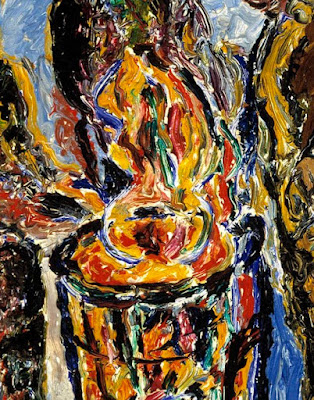On Thursday, February 9, 2023, the National Portrait Gallery hosted an online event called "In Dialogue: Smithsonian Objects and Social Justice."
It was one of a series of monthly events through which educators from the National Portrait Gallery partner with colleagues from across the Smithsonian to discuss how historical objects from their respective collections speak to today’s social justice issues.
This most recent dialogue featured Beauford's Can Fire in the Park, juxtaposing it with a haunting photographic self-portrait by LaToya Ruby Frazier. Both works were discussed with the intent to explore the following question:
"How does a community sustain well-being in the face of systemic inequity?"
The conversation began with an evaluation of Can Fire in the Park, painted during Beauford's New York years.
(1946) Oil on canvas
© Estate of Beauford Delaney
by permission of Derek L. Spratley, Esquire,
Court Appointed Administrator
The moderators asked attendees to type in the chat what they saw in the painting.
Responses included "silhouetted figures," "warmth," "circles," "lots of vibrant colors," and "heavy, with layers of design."
The moderators then asked attendees to type how the painting made them feel.
Responses included "hopeful," "a bit of sadness," "isolation," and "inequity and solidarity at the same time."
The more comments I read, the more my view of Can Fire began to shift. I realized that I had never truly examined the elements of this celebrated work.
I took advantage of the link provided by the Smithsonian to look at an image of the work on its Website, and I spent a lot of time using the zoom function to look at parts of the painting I had only skimmed over before.
One of the comments referred to the possibility that the scene was set on a basketball court. I realized that I had never paid attention to the red lines on the ground behind the group huddled around the can.
(1946) Oil on canvas
© Estate of Beauford Delaney
by permission of Derek L. Spratley, Esquire,
Court Appointed Administrator
I looked at the fire that gives the painting its name. For the first time, I saw what appears to be a circular object at the top of the can, the edges of which Beauford traced in vivid blue. Though the body of the can is glowing, the fire seems to emerge from this orb-like structure.
(1946) Oil on canvas
© Estate of Beauford Delaney
by permission of Derek L. Spratley, Esquire,
Court Appointed Administrator
I looked at the two human figures at the periphery of the group. Both have their arms crossed and both seem distant from the four people in the center. I always considered their arms to be folded because they were cold. But in looking at the painting through the lens of community, I now wonder if they are strangers to the people gathered around the can.
Another possibility is that they are standing guard so the people next to the fire can warm themselves undisturbed.
The person at the far left of the painting is well splattered with yellow. Perhaps light is shining on this figure, and perhaps the irregularly shaped caramel brown figure between this person and the short upward pointing arrow represents a shadow.
(1946) Oil on canvas
© Estate of Beauford Delaney
by permission of Derek L. Spratley, Esquire,
Court Appointed Administrator
I had always viewed the humans in the paintings as men. That night, for the first time, I thought that the person immediately to the right of the can might be a woman. The curved gold line atop the head (possibly a scarf or large ribbon) seems to wind its way down to the chest and torso of this person, and the curvature at the chest evokes a bustline. The broad strokes moving up and away from the face may represent a hair style - perhaps a large braid.
(1946) Oil on canvas
© Estate of Beauford Delaney
by permission of Derek L. Spratley, Esquire,
Court Appointed Administrator
Because of the height of the person immediately to "her" right, this figure may represent a teen or a large child.
(1946) Oil on canvas
© Estate of Beauford Delaney
by permission of Derek L. Spratley, Esquire,
Court Appointed Administrator
Then there is the figure standing at the left of the group of four people who are closest to the can. It is almost entirely outlined in yellow-gold.
Might this be a representation of Beauford himself?
(1946) Oil on canvas
© Estate of Beauford Delaney
by permission of Derek L. Spratley, Esquire,
Court Appointed Administrator










1 comment:
I well remember seeing such sights as I went to teach in Harlem at the alternative programs in the 1960s...and yes, the mix included others who needed to warm up, but mostly men...it always filled me with a mix and range of emotions as I was going to support and enable alternative education opportunities for high school youths so they could continue with higher education to move their own lives along and to keep warm in their own homes...
Post a Comment